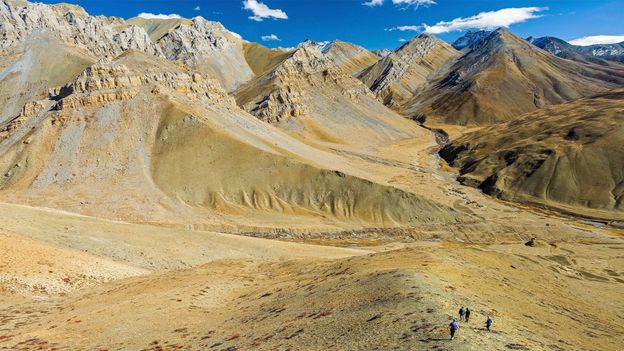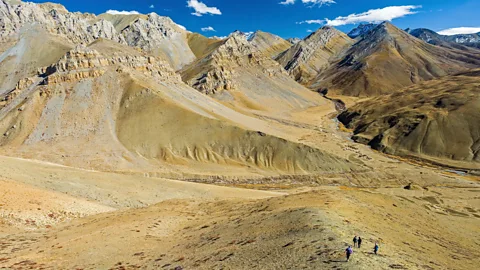 Alamy
AlamySet against a stunning Himalayan backdrop, this high-altitude hike is one of the best ways to experience one of Asia’s oldest religions and search for one of its most elusive animals.
Khenpo Nyima Samdrup, the abbot of Thasung Tsholing Gompa in Nepal, sat in front of a stove in the monastery’s tiny kitchen, dressed in layers of maroon robes and a woollen mustard hat. The day I visited, the surrounding mountains were hidden behind thick clouds and the wind skimmed across the lake from the north, bringing small ripples to its surface.
As he fed the fire with more wood, Khenpo explained that the monastery was founded around 400 years ago to protect snow leopards, musk deer and other animals from hunters. “Tha means ‘surrounding’ and sung means ‘conservation’ or ‘protection’,” he explained. “So, the name of the monastery means ‘preserving the surroundings’.”
Thasung Tsholing is a monastery of the ancient Bon religion set on the edge of Phoksundo Lake in Dolpo, in north-west Nepal. A rugged land of jagged gorges, high passes and secluded religious hermitages, the remote Dolpo region is culturally Tibetan and is one of the last vestiges of Bon – the indigenous religion practised across the Tibetan plateau before the arrival of Buddhism in 7th Century CE.
The monastery also lies on the Lower Dolpo Circuit – a 220km trekking trail that winds through the southerly reaches of Dolpo. Following the destruction of Bon and other religious sites in Tibet during the Cultural Revolution in the 1960s and ’70s, in which the Chinese government attempted to eradicate Tibet’s cultural and religious identity, Chinese forces sought to forcibly assimilate Tibetans. But because Dolpo lies just over the border in Nepal, it is one of very few places where the practice of Bon has continued uninterrupted for centuries. (Today, only 0.23% of Nepalis are Bon, with the majority of the population following the Hindu religion)
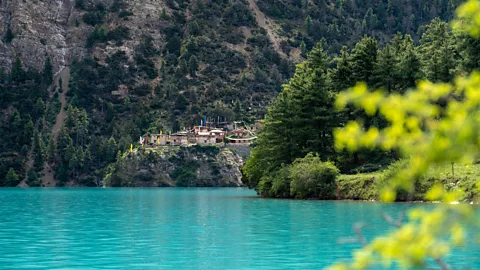 Eileen McDougall
Eileen McDougallThe Circuit connects four of the area’s six main Bon settlements, providing an unparalleled opportunity for hikers to discover this mysterious religion. A registered guide is required to trek in the region, and they can arrange for hikers to stay with Bon families, visit ancient Bon monasteries, meet local religious leaders and observe the slow, gentle rhythms of Bon culture – most notably, their reverence of their natural environment.
Bon followers consider certain animals and elements – such as mountains, rocks, rivers, canyons and springs – to be gods or protectors, and believe that their destruction will bring great misfortune to mankind. Humans must therefore ask permission from these gods before beginning any activity that uses the natural resources of the land – such as picking medicinal plants, quarrying for stone or planting seeds. Such beliefs, Bon followers say, encourage respectful and sustainable use of the surrounding environment. In an age of environmental destruction, this concept felt particularly poignant to me, and I travelled to Dolpo to see what lessons this ancient religious practice could hold for the modern world.
The Circuit starts at the ramshackle town of Dunai, a gruelling 36-hour bus journey north-west from Kathmandu. Accompanied by my Nepali trekking guide, Rejina Tamang, I followed the dusty trail eastwards, climbing past stone villages perched precipitously on the valley side.
The trail continued, rising and falling, the steps cut into red cliffsides high above the silver meander of the Bheri River. The Bon communities of Dolpo are agro-pastoralists – rearing goat, sheep, dzo and yak and growing a limited range of crops. It was September and almost harvest season; the golden barley glistened in the soft autumn wind.
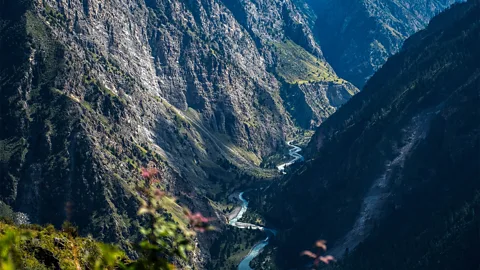 Eileen McDougall
Eileen McDougallTamang and I set out each morning at sunrise, covering anywhere from 10-25km depending on incline and altitude. During our 14-day trek, we slept in a mixture of traditional lodges in rammed-earth houses; temporary “tent-hotels” set between villages serving rice, lentils and local liquor; and a tent I carried in my trekking backpack.
Two-days in, the path turned northwards into a narrowing gorge, before emerging 40km north-east from Dunai in the arid valley of Dho-Tarap, one of Dolpo’s main centres. Most of Dho-Tarap’s Bon community live in the valley’s eastern end in a hamlet called Sipchok. Tamang and I found Sipchok’s monastery locked, but a passing local insisted on taking us to her home. Her husband, Geshe Yongden Pasang, was the Bon lama, or spiritual leader, of Dho-Tarap, and after an obligatory cup of butter tea, he happily showed us the monastery.
Sipchok Monastery is roughly 450 years old and has no electricity; the dim light from the small windows was just enough to make out the painted deities on the walls. Geshe Yongden explained that Dolpo was once part the ancient kingdom of Zhangzhung, centred around western Tibet, which has long been associated with Bon. Zhangzhung came to an end in 7th Century CE when it was conquered by the Yarlung, the first Central Tibetan dynasty. When the Yarlung chose Buddhism as the state religion, many followers of Bon hid their religious scriptures in the caves of holy mountains for safekeeping and fled to outer-lying Tibetan regions such as Dolpo.
Little is known about the practice of Bon in those early centuries, but today Bon shares many beliefs – such as karma, reincarnation and the pursuit of enlightenment – with Tibetan Buddhism. But as Geshe Yongden told me, the Bon have their own set of deities, rituals and a distinct story of origin.
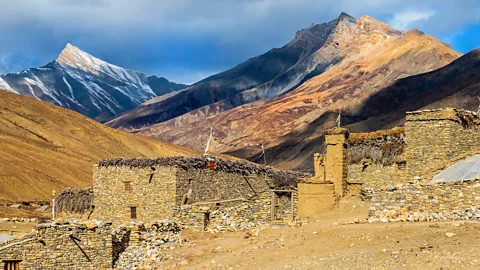 Alamy
AlamyHe explained that mountains are particularly important deities for the Bon, with the most prominent mountain in a valley being the Yulha, or “God of the place”. “If we make the Yulha angry, rain will not fall on time, diseases will spread, crops will not grow, the snow leopard will cause more damage to the livestock and there will be conflicts between people. But if we worship the Yulha properly, then it will rain on time, the crops will grow well, people will have happy minds, and the village will be peaceful,” he said.
With bad weather ominously approaching, we hiked 30km eastwards from Dho-Tarap towards Numa La, the first of two more-than-5000m passes on this part of the trail. We were now accompanied by Tenzin, a local horseman who knew the land, in order to deliver us safely across these sacred mountains to Thasung Tsholing Gompa.
When we arrived at Ringmo, the Bon village next to Thasung Tsholing Gompa, huge raindrops lashed down from dark clouds. Only when we passed the chortens, or shrines, on the outskirts of the village, did Tenzin allow us to stop and rest. He explained that these shrines mark the boundaries of each village and the threshold between the inhabited, safe areas and the wild domains of the gods.
The monastery sat on an area of flat land jutting out into the lake, where the only sounds were the rustle of tree branches and the tweeting of birds. However, Khenpo later explained this peaceful scene wasn’t always so. Before the monastery was built, this area was used as a trap for snow leopards and other endangered animals such as blue and musk deer. Hunters used dogs to drive the animals towards the monastery, trapping them on the rocky outcrop extending into the lake.
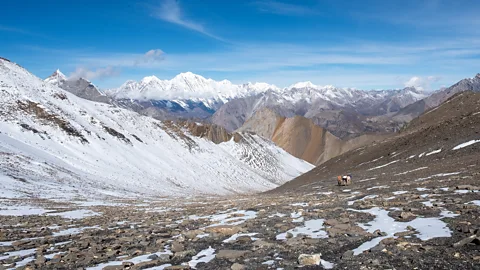 Eileen McDougall
Eileen McDougall“In the 17th Century, Treton Tshewang Tshultrim, an important Bon lama, came to the area and saw the hunters killing the animals. That’s why he founded this monastery where it is today,” Khenpo said. Hunters would not hunt in the vicinity of a Bon monastery, and its presence created a deterrent that remains to this day. “The precepts of our religion tell us that animals should be respected, and protecting them will help accumulate karmic merit,” he added.
Today, Dolpo’s mountains are believed to be home to the highest concentration of snow leopards in Nepal, and authorities in the surrounding Shey Phoksundo National Park (Nepal’s largest national park) estimate 90 of the nation’s 300-400 snow leopards to live in these mountainous folds. Geshe Yongden explained that snow leopards are sometimes seen on Sipchok’s surrounding crags. I kept my eyes alert for the elusive animal’s white-grey coat while walking, although Tamang explained that catching a glimpse of one is very unlikely.
According to Sonam Choekyi Lama, a filmmaker and conservationist from Dolpo, the fleeting creatures are greatly respected in local Bon communities due to their religious significance. “The locals consider the snow leopard the animal of God, and that they should be not disturbed by humans,” she told me.
After walking half a day west of Thasung Tsholing Gompa, Tamang and I arrived at Pugmo, the last Bon village on the trail. Nestled at the bottom of a narrow valley, Pugmo is famed for the many mountain gods believed to surround the village. We stayed with a local Bon family in Pugmo’s only lodge, and over dinner, the lodge’s owner, Migur Lama, explained how to find Pugmo’s spiritual leader: Norbu Lama.
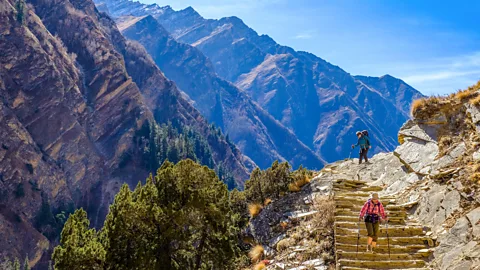 Alamy
AlamyWe eventually found him in his home, a former monastery, on hour outside the village. Sitting below faded photos of Bon leaders, Norbu pointed across the valley towards the contortions of rock and explained that Bon followers consider the many natural deities around them as “landscape lords” or protectors, overseeing their particular area of the natural environment.
Back in Migur’s guesthouse, Lhakpa Bhutti, a female yak herder from a neighbouring house, explained what could happen when people fail to adequately respect these landscape lords. “These days, I am losing more and more yak to attacks by Himalayan wolves. This is because we have been making the Yulha angry,” she said, as we sipped tea around the fireplace.
“The protectors’ permission is vital to the functioning of daily life in this area,” agreed Sonam Choekyi. “And if enraged, through harmful activities, there will be consequences in all areas of life.”
Before we headed down from the mountains, I visited Norbu one last time and asked what changes he has seen in his lifetime. He explained there is a Tibetan calendar that forecasts the weather. “Until recently, the weather has progressed according to this calendar. But not anymore. The age has changed, the gods are very angry. Because these days, many natural places are being destroyed,” he sighed.
 Eileen McDougall
Eileen McDougallAs the sky turned dark, Norbu said goodbye and retreated to his home for prayer. I could hear his low voice chanting long incantations as I walked away, and I wondered what the world might be like if we all had sought nature’s permission before taking from it.
Slowcomotion is a BBC Travel series that celebrates slow, self-propelled travel and invites readers to get outside and reconnect with the world in a safe and sustainable way.

